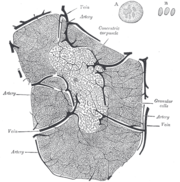Thymus
|
|
In human anatomy, the thymus is a ductless gland located in the upper anterior portion of the chest cavity. It is most active during puberty, after which it shrinks in size and activity in most individuals and is replaced with fat. The thymus plays an important role in the development of the immune system in early life, and its cells form a part of the body's normal immune system.
The thymus is also present in many other animals. When animal thymus tissue is sold in a butcher shop or at a meat counter, thymus is known as sweetbread.
| Contents |
Function
The thymus is part of the immune system. In its lobules lymphocytes mature into T cells (where T stands for “thymus”) that behave in different ways according to their type. Some are passed into the bloodstream where they perform vital immune functions. Others remain in the thymus to give rise to future generations of T cells.
Anatomy
The thymus will, if examined when its growth is most active, be found to consist of two lateral lobes placed in close contact along the middle line, situated partly in the thorax, partly in the neck, and extending from the fourth costal cartilage upward, as high as the lower border of the thyroid gland. It is covered by the sternum, and by the origins of the Sternohyoidei and Sternothyreoidei. Below, it rests upon the pericardium, being separated from the aortic arch and great vessels by a layer of fascia. In the neck it lies on the front and sides of the trachea, behind the Sternohyoidei and Sternothyreoidei. The two lobes generally differ in size; they are occasionally united, so as to form a single mass; and sometimes separated by an intermediate lobe. The thymus is of a pinkish-gray color, soft, and lobulated on its surfaces. It is about 5 cm in length, 4 cm in breadth below, and about 6 mm in thickness. At birth it weighs about 15 grams, at puberty it weighs about 35 grams; after this it gradually decreases to 25 grams at twenty-five years, less than 15 grams at sixty, and about 6 grams at seventy years.
Development
The thymus appears in the form of two flask-shaped endodermal diverticula, which arise, one on either side, from the third branchial pouch, and extend lateralward and backward into the surrounding mesoderm and neural crest-derived mesenchyme in front of the ventral aorta. Here they meet and become joined to one another by connective tissue, but there is never any fusion of the thymus tissue proper. The pharyngeal opening of each diverticulum is soon obliterated, but the neck of the flask persists for some time as a cellular cord. By further proliferation of the cells lining the flask, buds of cells are formed, which become surrounded and isolated by the invading mesoderm. In the latter, numerous lymphoid cells make their appearance, and are agregated to form lymphoid follicles. These lymphoid cells are probably derivatives of the entodermal cells which lined the original diverticula and their subdivisions. Additional portions of thymus tissue are sometimes developed from the fourth branchial pouches. Thymus continues to grow until the time of puberty and then begins to atrophy.
Structure
Each lateral lobe is composed of numerous lobules held together by delicate areolar tissue; the entire gland being enclosed in an investing capsule of a similar but denser structure. The primary lobules vary in size from that of a pin's head to that of a small pea, and are made up of a number of small nodules or follicles, which are irregular in shape and are more or less fused together, especially toward the interior of the gland. Each follicle is from 1 to 2 mm. in diameter and consists of a medullary and a cortical portion, and these differ in many essential particulars from each other. The cortical portion is mainly composed of lymphoid cells, supported by a network of finely branched epithelial cells, which is continuous with a similar network in the medullary portion. This network forms an adventitia to the bloodvessels. In the medullary portion the reticulum is coarser than in the cortex, the lymphoid cells are relatively fewer in number, and there are found peculiar nest-like bodies, the concentric corpuscles of Hassall. These concentric corpuscles are composed of a central mass, consisting of one or more granular cells, and of a capsule which is formed of epithelioid cells . They are the remains of the epithelial tubes which grow out from the third branchial pouches of the embryo to form the thymus. Each follicle is surrounded by a vascular plexus, from which vessels pass into the interior, and radiate from the periphery toward the center, forming a second zone just within the margin of the medullary portion. In the center of the medullary portion there are very few vessels, and they are of minute size.
The arteries supplying the thymus are derived from the internal mammary, and from the superior and inferior thyroids. The veins end in the left innominate vein, and in the thyroid veins. The nerves are exceedingly minute; they are derived from the vagi and sympathetic. Branches from the descendens hypoglossi and phrenic reach the investing capsule, but do not penetrate into the substance of the gland.
Cancer
Tumors of the thymus are found in about 10% of patients with myasthenia gravis.
Thymus (family Lamiaceae) is the genus of plants to which thyme belongs.
Anatomy Clipart and Pictures
- Clip Art (https://classroomclipart.com)
- Anatomy Illustrations (https://classroomclipart.com/clipart/Illustrations/Anatomy.htm)
- Anatomy Clipart (https://classroomclipart.com/clipart/Anatomy.htm)
- Anatomy Animations (http://classroomclipart.com/cgi-bin/kids/imageFolio.cgi?direct=Animations/Anatomy)
|
Lymph nodes - Lymph - Lymphocytes - Lymph vessels - Thoracic duct |
|
Bone marrow - Spleen - Thymus - Tonsils |


